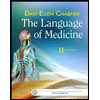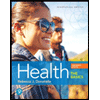
To describe: The stages of fetal development and the basic effects on the mother.
Introduction: Gestation or pregnancy is the period during which offspring develops within a woman. There involves several developmental stages of fetus.
Explanation of Solution
Fertilization
The gametogenesis occurs in males and females. Males produce sperms and females produce eggs. During intercourse between a male and female, the male’s sperms are ejaculated into the female reproductive tract. In the fallopian tube, fertilization takes place. Fertilization is the phenomenon where the male gamete (sperm) and the female gametes (egg) unite to form the zygote. The zygote develops as the fetus in the uterus. At the end of gestation period, the act of the female where she gives birth to the baby is known as parturition.
Stages of fetal development
In humans, pregnancy is nearly nine months long, divided into three trimesters, involving several changes in the mother and the growing fetus. The developmental stages begin as a fertilized egg. This egg develops into a blastocyst, then to an embryo and at last to a fetus.
Tabular representation: Table 1 shows the stages (three trimesters) of fetal development.
Table 1: The stages of fetal development
|
Stages |
Weeks of pregnancy |
Events |
|
First trimester (1 to 12 weeks) |
2 |
|
|
3 |
| |
|
5 |
| |
|
6-9 |
| |
|
10 |
| |
|
Second trimester (13 to 27 weeks) |
14-16 |
|
|
20-24 |
| |
| Third trimester (28 to 40 weeks) |
25-40 |
|
Effects on the mother during first trimester
During the first trimester, a mother’s body undergoes rapid changes. Some changes include breast tenderness, heightened sense of taste and smell, and morning sickness. Morning sickness is the feeling of nausea and vomiting. Morning sickness is caused by hormonal changes in the mother. Vomiting and nausea due to morning sickness also cause loss of appetite in mothers during early pregnancy. Vomiting also causes loss of nutrients and body is deprived of nutrition and calories. Low motility of digestive tract also affects appetite and food intake, leading to weight loss.
Effects on the mother during second trimester
During second trimester, certain unpleasant effects of first trimester may reduce or even disappear as a pregnant woman’s body gets adapted to the hormonal changes. There will be an increase in energy level and the person may easily feel sleepy. Also, they experience pelvic pressure. Only a low chance of miscarriage occurs during this stage.
Effects on the mother during third trimester
The average weight increase during the three trimesters is 25 to 30 pounds, most of which occurs during the third trimester. The weight gain occurs due to several changes in mother such as the enlarged uterus, increase in uterus contents (the placenta, the amniotic fluid, and growing fetus), breast enlargement, increased blood volume, and increase in stored nutrients or body fat. Women begin their pregnancy at a healthy weight during third trimester. At the end of the third trimester, the approximate weight of a baby is about 7 pounds. During the third trimester, many pregnant women who begin their pregnancy at a healthy weight, should intake 450 calories more each day than they did before pregnancy to gain a pound per week.
Want to see more full solutions like this?
Chapter 22 Solutions
GOULD'S PATHOPHYS.F/...-ACCESS >CUSTOM<
 The Language of Medicine, 11eHealth & NutritionISBN:9780323370813Author:Davi-Ellen Chabner BA MATPublisher:Saunders
The Language of Medicine, 11eHealth & NutritionISBN:9780323370813Author:Davi-Ellen Chabner BA MATPublisher:Saunders Gordis EpidemiologyHealth & NutritionISBN:9780323552295Author:David D. Celentano, Moyses SzkloPublisher:ELSEVIER
Gordis EpidemiologyHealth & NutritionISBN:9780323552295Author:David D. Celentano, Moyses SzkloPublisher:ELSEVIER Nutrition Through The Life CycleHealth & NutritionISBN:9781337919333Author:Brown, Judith E.Publisher:Cengage Learning,
Nutrition Through The Life CycleHealth & NutritionISBN:9781337919333Author:Brown, Judith E.Publisher:Cengage Learning, Health: The Basics (13th Edition)Health & NutritionISBN:9780134709680Author:Rebecca J. DonatellePublisher:PEARSON
Health: The Basics (13th Edition)Health & NutritionISBN:9780134709680Author:Rebecca J. DonatellePublisher:PEARSON Understanding Nutrition (MindTap Course List)Health & NutritionISBN:9781337392693Author:Eleanor Noss Whitney, Sharon Rady RolfesPublisher:Cengage Learning
Understanding Nutrition (MindTap Course List)Health & NutritionISBN:9781337392693Author:Eleanor Noss Whitney, Sharon Rady RolfesPublisher:Cengage Learning Introduction To Health PhysicsHealth & NutritionISBN:9780071835275Author:Johnson, Thomas E. (thomas Edward), Cember, Herman.Publisher:Mcgraw-hill Education,
Introduction To Health PhysicsHealth & NutritionISBN:9780071835275Author:Johnson, Thomas E. (thomas Edward), Cember, Herman.Publisher:Mcgraw-hill Education,





